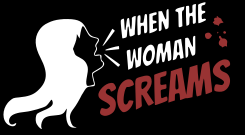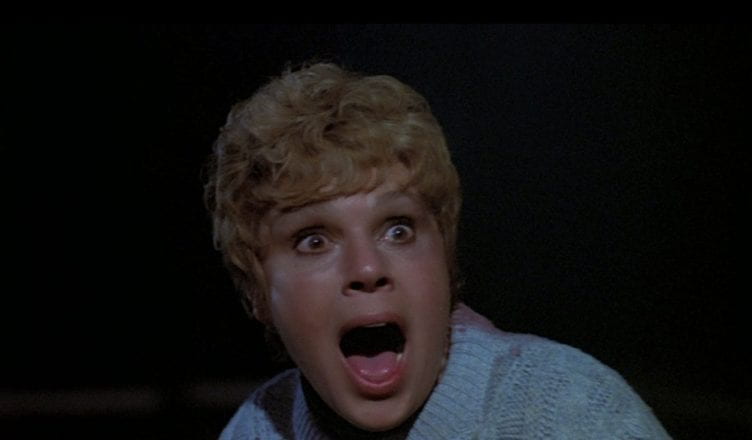Film Deets:
Director: Sean S. Cunningham
Screenplay: Victor Miller
Actresses: Betsy Palmer, Robbi Morgan
Category: Maternal Grief
Themes: Grief, Psychotic Break
Why do these screams matter?
A quintessential slasher film with a depraved killer, teenage camp counselors, explicit gore, and a remote location that screams Americana, Friday the 13th (1980) is not a film immediately associated with maternal grief. And yet, it is the loss of a child that fuels the narrative from beginning to end. Directed by Sean S. Cunningham, the film is an acknowledged slasher classic that leans into its subgenre tropes while also demonstrating that the line between grief and madness is not always clear. The film takes place at Camp Crystal Lake, a once-popular summer camp that is about to be reopened after having been shuttered for years in the wake of a young boy’s drowning. But an unseen killer has no intention of letting that happen.
The first kill of the film happens relatively quickly and it involves Annie (Robbi Morgan), a counselor trying to find her way to Camp Crystal Lake. Having taken a wrong turn, she decides to hitch a ride only to wind up in the vehicle of the killer. In this scene, she jumps from the moving car but is unable to escape.
On its surface, this first scream is a typical one for a slasher film in that Annie has just been pursued through the woods by the killer before meeting a savage end. But here, the scream is muffled, likely owing to Annie’s throat being cut. Instead, the dominant sound overtaking the scene is the swelling sound of music with beats suggesting a stabbing motion. This musical cue not only alerts the audience that violence is imminent but it also shifts the narrative focus away from Annie toward the killer, further obscuring Annie’s voice. Interestingly, the scene begins with the distress cries of a loon whose sounds could be read to mimic the scream Annie will be unable to fully release. Because these sounds happen in anticipation of Annie’s attempt to scream, they work as both an extension of Annie’s voice and as a warning that Annie is at risk. But that reading only works up until the killer’s reveal.
What’s fascinating about this scene is how differently it reads once you know the identity of the killer. Typically described as “mournful,” the sound made by the loon takes on new resonance once we realize who is behind the killings and reframes the scene not as one that gives Annie a voice but one that acknowledges the trauma fueling the killer’s motivations (Henderson 145). That the loon is on the same lake as where the killer’s child died further adds to this bit of poignancy that occurs just before the murder spree begins.
The killer’s reveal also upends the audience’s understanding of Annie and her decision making. Fans of the slasher genre expect to mock the bad decisions being made by the characters throughout the film because the built-in expectation is that their stupidity is a contributing factor in their demise. It’s why we groan when we see a character fleeing up the stairs of a house instead of out the door. As viewers, we know that these decisions will have consequences and it’s also an opportunity for those of us watching to pat ourselves on the back and think we’d never be that stupid. Our initial impression of Annie is that she is making an incredibly dumb decision getting into the car of someone she doesn’t know. Her scream here works, at least initially, as confirmation of that poor decision, but the film’s ending revelation that Mrs. Voorhees (Betsy Palmer) is the person behind the wheel reframes Annie’s scream. With her conservative haircut and practical sweater and slacks combo, Mrs. Voorhees looks like the image of a good mother. And here, good equates to trustworthiness. The person Annie sees behind the wheel isn’t some shifty-looking man who raises culturally ingrained suspicions, but the exact opposite (Logan and Walker 604-605; Bohm 195). And so, while her scream is one of fear, it is also fueled by the shock of being confronted with the knowledge that safety is an illusion and that sometimes the most dangerous threat looks like the mother next door.
This intersection of perceived wholesomeness and psychosis comes into play in our second scream. Having dispatched all of the campers but final girl Alice (Adrienne King), Mrs. Voorhees reveals to the traumatized girl her identity as the killer. And she provides insight into the reason behind her killing spree.
 Mrs. Voorhees’ scream as she moves to attack Alice is a complicated one. As a mother whose child has died, she occupies a space of maternal Otherness that invites pity even while her bloody actions invite disgust. On the surface, Mrs. Voorhees’ rage is directed toward the camp counselors who were too self-involved to responsibly care for the children left in their charge. But her monologue at this moment also indicates a feeling of responsibility for Jason’s death. By pointing out that she was working when it happened, the unspoken suggestion is that if she had been home being a good mother, then Jason would still be alive. Instead, she was cooking, an overtly domestic act, but in service of the camp counselors instead of her child.
Mrs. Voorhees’ scream as she moves to attack Alice is a complicated one. As a mother whose child has died, she occupies a space of maternal Otherness that invites pity even while her bloody actions invite disgust. On the surface, Mrs. Voorhees’ rage is directed toward the camp counselors who were too self-involved to responsibly care for the children left in their charge. But her monologue at this moment also indicates a feeling of responsibility for Jason’s death. By pointing out that she was working when it happened, the unspoken suggestion is that if she had been home being a good mother, then Jason would still be alive. Instead, she was cooking, an overtly domestic act, but in service of the camp counselors instead of her child.
This moment is a startling recognition of the societal pressures placed on women to be “good mothers,” while also being steeped in a conservative ideology that views a mother who works outside of the home as somehow lesser than mothers who do not. Ronald Reagan’s election in 1980 ushered in a new wave of Christian conservatism that equated having strong family values with being a stay-at-home mother (Dowland 607). And yet, conservative, working mothers like Phyllis Schlafly, Anna Chennault, Beverly LaHaye, and Sandra Day O’Connor rose through the Republican ranks balancing their family obligations with their professional ambitions such that by 1980, they all occupied important political positions of power. But all these women also occupy a very different economic sphere from the one represented by Mrs. Voorhees. She doesn’t work because she wants to, she works because – as a single mother – she has to. Although this conversation has shifted somewhat within conservative circles in recent years due to economic realities that often necessitate dual income households, at the time this film was made there was a clear framing of working mothers as potentially damaging their children through neglect (Schreiber 3-4). And it is this same framing that underpins the guilt and trauma Mrs. Voorhees experiences about Jason’s death.
With Jason’s father wholly missing from the narrative, the maternal bond between Jason and Mrs. Voorhees becomes even more pronounced. When Mrs. Voorhees says, “I am Jason” before attacking Alice, she is embodying Barbara Creed’s idea of the archaic mother, an archetype of the monstrous-feminine, in which mother and child are co-dependent to the point neither can exist independently. As Creed writes, “The desires and fears invoked by the image of the archaic mother, as a force that threatens to reincorporate what it once gave birth to, are always there in the horror text – all pervasive, all encompassing – because of the constant presence of death” (28). Here, Mrs. Voorhees has devoured her son’s memory to the point where she has “reincorporated” the deceased Jason back into the mortal world and has entwined his agency with her own. She becomes abject not only because she violates boundaries by murdering innocent young people, but because she refuses to separate from her child to the point where they become indistinguishable from one another.
That this reckoning with the past takes place in the cabin, the de facto summer home of the teen counselors, is by design. Mrs. Voorhees, who never has an identity beyond being explicitly framed as a mother, is returning to a surrogate home to enact revenge for a loss she attributes, at least in some part, to her working outside of the home. The scream she releases as she moves to kill Alice is a wounded one encompassing her rage and her grief at the loss of her child. It’s also an auditory marker that hammers home the point that her psychotic break is the result of profound grief that she no longer has a child to mother. It’s easy to rank Mrs. Voorhees among the homicidal bad mothers of horror but doing so without acknowledging her maternal grief, a grief that is exacerbated by cultural messaging that being a good mother means adhering to traditional gender roles and staying in the home, does a vast disservice to the complexity of her motivations.
Works Cited
Bohm, Robert M. “Crime, Criminal and Crime Control Policy Myths.” Justice Quarterly, vol. 3, no. 2, 1986, pp. 193-214.
Creed, Barbara. The Monstrous-Feminine: Film, Feminism, Psychoanalysis. Routledge, 2015, pp. 8-30.
Dowland, Seth. ““Family Values” and the Formation of a Christian Right Agenda.” Church History, vol. 78, no. 3, 2009, pp. 606-631.
Friday the 13th. Directed by Sean S. Cunningham, performances by Betsy Palmer, Robbi Morgan, and Adrienne King, Paramount Pictures, 1980.
Henderson, A. D. “The Common Loon in Alberta.” The Condor, vol. 26, no. 4, 1924, pp. 143-145.
Logan, T. K., and Robert Walker. “The Gender Safety Gap: Examining the Impact of Victimization History, Perceived Risk, and Personal Control.” Journal of Interpersonal Violence, vol. 36, no. 1, 2021, pp. 603-631.
Schreiber, Ronnee. “Gender Roles, Motherhood, and Politics: Conservative Women’s Organizations Frame Sarah Palin and Michele Bachmann.” Journal of Women, Politics & Policy, vol. 37, no.1, 2016, pp. 1-23.







